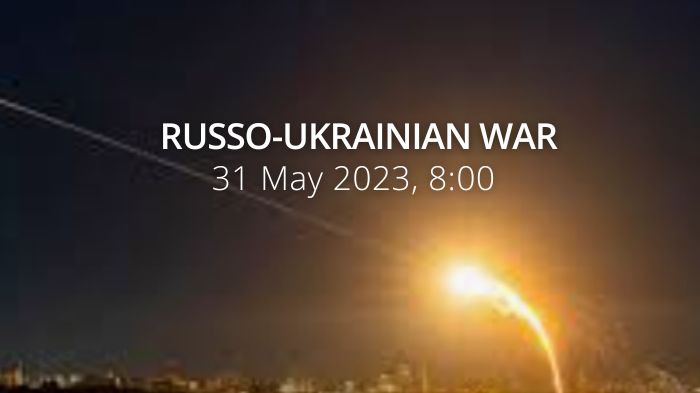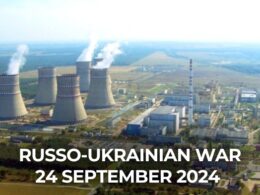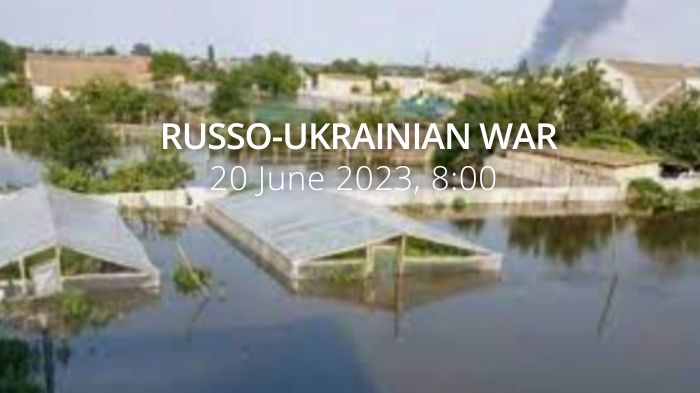Ukrainian troops cross the Inhulets river and counterattack in the northeast of Kherson Oblast, resume attacks in Kharkiv Oblast as Russia stays focused on advancement in Luhansk and Donetsk oblasts, seeks to resume its offensive from Izium. Ukrainian partisan activity continues to impose costs on Russian occupation forces in Ukraine's south. Satellite imagery shows Russia's vehicles deployed on Zmiinyi Island. Putin signs a law allowing the contract army service for older people, up to age 65. Russia loots metal produce in occupied Mariupol. The EU looks into the option of a naval mission to unblock food exports from Ukraine as Ukraine wants the world to make Moscow end the blockade of Ukrainian ports.
Situation
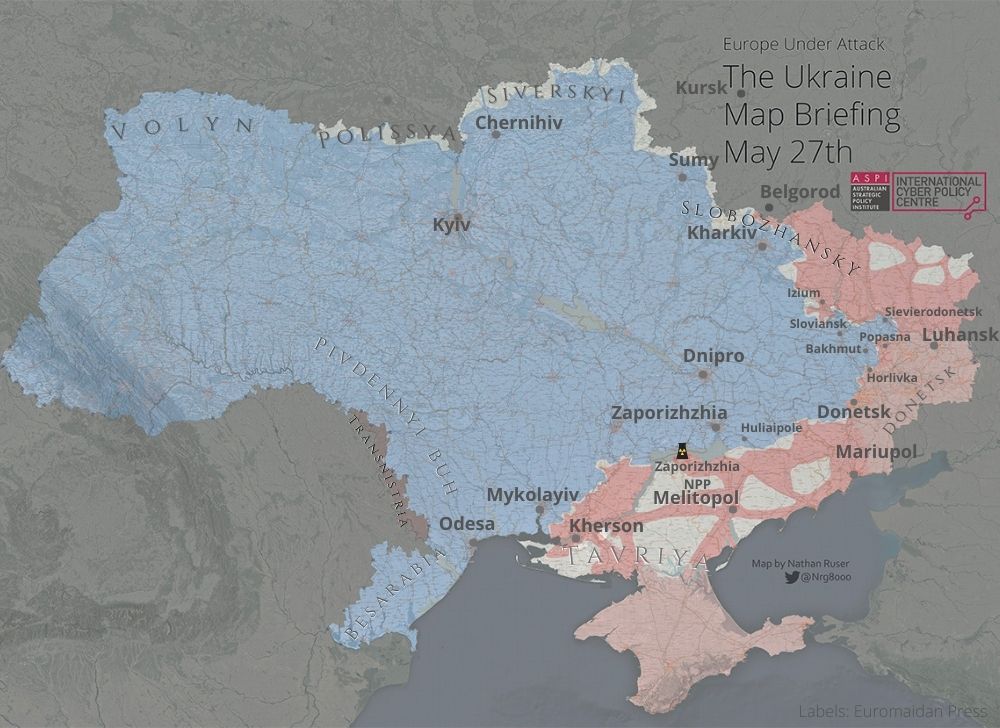
Heavy fighting in Luhansk Oblast and counter-offensives of the Armed Forces of Ukraine in Kharkiv and Kherson oblasts.
The Ukrainian forces are attacking again in Kharkiv Oblast, this time in the triangle Lobanivka - Dementiivka - Hoptivka and in the area of Vovchansk. The goal is to push the Russian artillery away from Kharkiv and cut the right flank of their group of forces which is aimed at Izium and beyond.
Trying to resume their assault from Izium (Kharkiv Oblast) on Sloviansk (Donetsk Oblast), Russians fired on the Ukrainian positions in the areas of Nova Dmytrivka, Velyka Komyshuvakha, Dovhenke, Dibrova. Also, Russian helicopters hit the Ukrainian positions in the area of Dovhenke.
A map of the approximate situation on the ground in Ukraine as of 00:00 UTC 29/05/22.
There have been no significant changes to control since the last update. pic.twitter.com/N376a3hL9T
— War Mapper (@War_Mapper) May 29, 2022
On 27 May, Russians announced that they had captured Lyman, Donetsk Oblast. On the next day, Dep. Defense Minister Hanna Maliar denied this information, saying that fighting was underway in the city and that it was incorrect to talk about the city as being captured while the fighting continues,
"One can say unequivocally: the situation is difficult, but the Armed Forces of Ukraine are fighting back."
Russians stated they had captured an undamaged Starlink user terminal in Lyman.
To Sloviansk's north, battles rage in the area of Sviatohirsk-Bohorodychne. The fall of Lyman wouldn't be crucial, because Ukraine's next line of defense will be high grounds along the bank of the Siverskyi Donets.
On 27 May, Russian forces seized the Myr Hotel on the northeastern outskirts of Sievierodonetsk, Luhansk Oblast. Heavy fighting is still going on in the area. Russian shelling attacks turned, Sievierodonetsk into ruins almost completely. Despite the fighting in the city, Ukraine keeps holding Borivske, south of Sievierodonetsk, inflicting heavy losses on the enemy. The Bakhmut-Lysychansk route remains under Ukrainian control, although it is completely exposed to Russian fire.
https://twitter.com/EuromaidanPress/status/1530603055321796609
Russian troops keep trying to actively advance from Popasna, Luhansk Oblast, in three directions - north, south, and west. Fighting continues near Soledar and Bakhmut (Donetsk Oblast), Komyshuvakha, Toshkivka, and Zolote. In the south, the Russians have advanced to Novoluhanske (Donetsk Oblast).
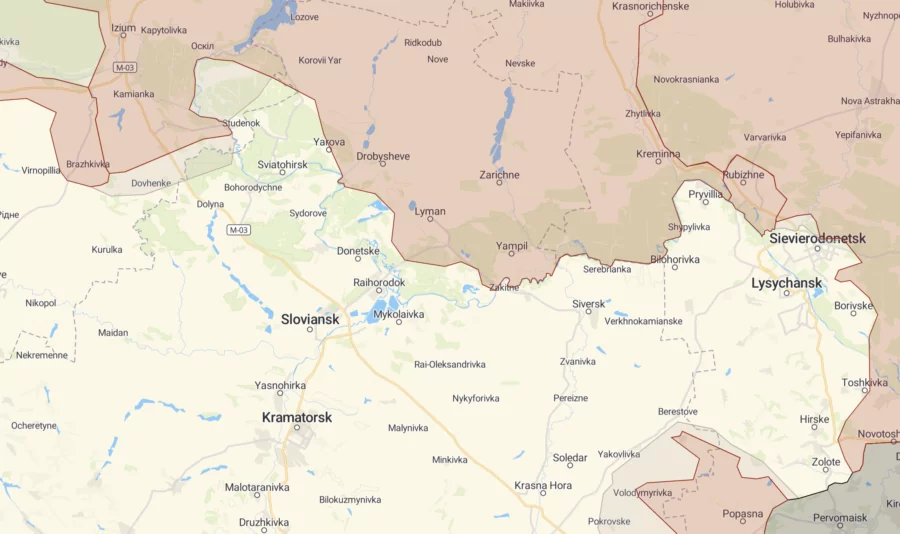
Zaporizhzhia Oblast sees local battles along the line of contact with mutual artillery shelling attacks, inflicting losses on both sides.
In the north of Kherson Oblast, Ukrainian forces went on the offensive, with the support of American 155-mm M777 guns. In the course of 28 May, there were reports on the Ukrainian nine-kilometer-deep advancement that reached the village of Bruskynske. However, in the evening, the General Staff said that Russians "took up defense at unfavorable frontiers near Andriivka, Lozove, and Bilohirka in Kherson Oblast." All these villages are located near the front line, so there's no reliable source for the "9 km breakthrough."
https://twitter.com/EuromaidanPress/status/1530581854541295617
Against this backdrop, the Russians completely blocked the exit to the Ukraine-controlled territories from occupied Kherson Oblast.
It is worth noting that on the entire front from Kharkiv to Kherson, the Armed Forces launched counterattacks at two extreme points, near Kharkiv and Kherson. Despite the media effect of the phrase "Ukrainian counter-offensive," these are now secondary areas with only limited forces deployed from both sides. Meanwhile, both sides have their main forces concentrated in the Donbas, where Ukrainian troops don't carry out any counterattacks so far.
Morning report day 95 – May 29
The report is based on media reports, expert analyses, and official information posted online.
Information from the General Staff as of 06.00 29.05.2022, supplemented by its [18:00 assessment] is in the drop-down box below.
- [Certain units of the Armed Forces of the Republic of Belarus continue to protect the Belarusian-Ukrainian border on a rotating basis, the grouping has been strengthened by units of brigades of internal troops of the Ministry of Internal Affairs of the Republic.]
- [To ensure enhanced administrative, police, and counterintelligence regimes in the Republic of Belarus until August 31, 2022, temporary restrictions are imposed on entry and stay on the border with Ukraine Bragin, Loiv, and Khoiniki districts of Gomel region.]
In the Siverskyi direction, Russian forces continue to cover the Ukrainian-Russian border in the Bryansk and Kursk regions. It fired mortars at the positions of the Defense Forces in the Sumy region. [To prevent the transfer of our troops to other threatening directions, Russian forces keep troops on the section of the Russian-Ukrainian border in the Bryansk and Kursk regions. Russian forces rotate part of the units and improve the engineering equipment of the concentration areas.]
- [Russian forces fired mortars four times at the positions of the border service units in the areas of the settlements of Seredyna Buda, Stari Vyrky, and Znob-Trubichevska. In addition, an operational and tactical aircraft from the airspace of the Kursk region fired a missile at a civilian industrial facility in the Sumy region.]
- [To clarify the position of our troops, Russian forces conducted air reconnaissance with the help of UAVs in the Chernihiv and Sumy regions.]
In the Slobozhanskyi direction, Russian forces exert systematic fire to prevent the further advance of our units in the direction of the State Border of Ukraine. Takes measures to replenish the loss of weapons and military equipment.
- In the Kharkiv direction, Russian forces focused their main efforts on maintaining the occupied frontiers and deterring units of the Defense Forces. He fired on civilian infrastructure in the areas of Cherkasky Tyshky, Ruski Tyshky, Petrivka, and Ternove. It continued the activities of remote mining of the area in the probable areas of action of the Defense Forces.
- In the Sloviansk direction, Russian forces did not conduct active hostilities, conducted intensive reconnaissance. The main efforts were focused on maintaining the occupied positions and creating conditions for the resumption of the offensive. Replenishes losses and inventories. [Russian forces are taking measures to resume the offensive in certain areas. The enemy continues to transfer weapons, military equipment, and other material resources from the territory of the Russian Federation to the Kupiansk district of the Kharkiv region by rail.]
- It carried out artillery shelling of civilian infrastructure in the areas of the settlements of Husarivka, Velyka Komyshuvakha, Bohorodychne, Sviatohirsk, and others. it continued to launch airstrikes in the Dovgenky area by the army aviation forces.
- [After conducting reconnaissance with unmanned aerial vehicles yesterday, it fired artillery at the positions of our troops in the settlements of Nova Dmytrivka, Velyka Komyshuvakha, Dovhenke, Dibrova, and struck with helicopters in the area of Dovhenke.]
- [With the support of artillery, Russian forces yesterday tried to develop offensive operations in the area of the settlement of Pasyka, but were unsuccessful and withdrew.]
Russian forces are conducting offensive operations in the Donetsk direction. Actively uses the forces and means of missile forces and artillery and electronic warfare. Increased the intensity of operational-tactical and army aviation. [The Russian aggressor yesterday conducted active hostilities in the Lyman, Sievierodonetsk, Bakhmut, Kurakhove, and Avdiivka directions. The main goal is to surround our troops in the areas of Lysychansk and Sievierodonetsk and reach the administrative border of the Luhansk region.]
- In the Lyman direction Russian forces strengthen the group. It used assault aircraft near Dibrova. It is trying to gain a foothold in the area of the Lyman settlement.
- In the Sievierodonetsk direction, with the support of artillery, it carried out assault operations in the area of the city of Sievierodonetsk, the fighting continues. In the area of the settlement of Bobrove, the enemy suffered losses and retreated to previously occupied positions. Assault aircraft launched airstrikes in the Ustynivka area. [Yesterday, Russian forces, with the support of artillery, led an offensive in the direction of Borivsky, suffered losses, and retreated to previously occupied positions.]
- Russian occupiers are trying to improve the tactical situation in the Bakhmut direction. With the support of mortar and artillery fire, the enemy conducted offensive and assault operations in the areas of the settlements of Volodymyrivka, Vasylivka, Komyshuvakha, and Myronivka. He was unsuccessful, suffered losses, and left. Army strikes near Yakovlivka. [Yesterday, Russian invaders tried unsuccessfully to improve the tactical situation in the areas of Komyshuvakha and Novoluhanske. Fighting continues.]
- In the Avdiivka direction, with the support of artillery, Russian forces tried to advance in the areas of the settlements of Kamianka and Vesele but were unsuccessful. [Yesterday, assault aircraft struck in the areas of Avdiivka, Vesele, and Kamianka.]
- It did not carry out active offensive operations in the Kurakhove, Novopavlivka, and Zaporizhzhia directions and fired on civilian infrastructure along the line of contact. [Russian forces waged a counter-battery battle and fired on our troops.]
- For the past 24hrs, seven Russian forces attacks have been repulsed in Donetsk and Luhansk only, one tank and six enemy vehicles have been destroyed. and Air defense units destroyed Orlan-10 UAVs. Russian forces have losses in other areas.
In the Pivdennyi Buh direction, Russian forces suffered losses as a result of offensive actions of Ukrainian units and took up defense on unfavorable borders near the village of Kostromka. Takes measures to restore lost positions by transferring reserves to threatening areas.
- [As a result of the offensive actions of units of the Defense Forces yesterday, Russian forces suffered losses and occupied the defense on unfavorable frontlines near Andriivka, Lozove, and Bilohorka, in Kherson oblast. The fighting continues.]
- Russian occupiers inflicted fire damage on civilian infrastructure in the areas of the settlements of Lymany, Stepova Dolyna, Luch, Partizany, Chervony Yar, Trudolyubivka, and others.
- [With the help of S-300 anti-aircraft missile systems, the enemy continues to increase the air defense system.]
- To make up for the losses, the enemy reinforces the group with obsolete weapons and military equipment, in particular, T-62, and BMP-1 tanks.
- The situation in the Besarabian direction has not changed significantly.
- Restrictive measures are underway in the Transnistrian region of the Republic of Moldova, inspections of infrastructure, transport, and citizens have been intensified and control over the use of cars equipped with special equipment has been strengthened.
[Two warships with naval-based Caliber missiles are ready for use in the Black Sea.]
The enemy continues to suffer losses. In particular, sanitary, which necessitates the creation of additional opportunities for medical care. Thus, in the temporarily occupied territory of the Autonomous Republic of Crimea, the occupation administration ordered to stop accepting civilians to vacate the beds for the wounded. Donor blood is being collected intensively.”
The Commander of Ukrainian Defense Forces Naiev: the situation is difficult on the front but is completely under control reports, the Ukrainska Pravda reported Saturday. "In Donetsk Oblast and especially in Luhansk Oblast, the enemy is increasing its forces and intends every day and night to carry out the task of reaching certain areas with further efforts to surround the Ukrainian troops, General Serhii Naiev said.
“The military command is taking comprehensive measures to respond to these intentions of the enemy properly. Our defenders, at the cost of their own lives and health, are restraining enemy attacks and doing everything possible to maintain those parts of the front where the enemy continues to accumulate additional forces and resources. Naiev also said that the Ukrainian Armed Forces are strengthening defense on Kharkiv and Zaporizhzhia fronts.”
Sievierodonetsk celebrates its 88th anniversary under enemy fire, but flying the Ukrainian flag, the Ukrinform reports.
"History repeats itself, today, as in 2014, Sievierodonetsk celebrates its birthday under enemy fire. And just as eight years ago, we will destroy and push the enemy back, but no longer just to Donetsk, but to the easternmost border of Ukraine, [Serhiy Haidai, the head of the Luhansk Regional State Administration, wrote on Telegram].”
Russian military equipment has been spotted on Zmiinyi (Snake) Island, the Ukrinform reports.
“Russian invaders have deployed about a dozen of military equipment units on Snake (Zmiinyi) Island and two Russian vessels are now seen there. The relevant satellite images were posted by OSINT blogger Tim Ehrhart on Twitter”.
Putin signs a law admitting people to the army under contract up to age 65, the Ukrainska Pravda reports, citing TASS.
“Putin has signed a law abolishing the age limit for concluding the first contract with the Russian Armed Forces. According to the State Duma website, people will now be able to serve in the army under a contract until they reach retirement age (which is 60 for women and 65 for men - ed.). Russia’s Deputy Defense Minister clarified that it will be possible to sign the first contract for military service in Russia up until the age of 50.”
According to British Defense Intelligence, (last 24 hours):
- On 25 May, Russia’s deputy foreign minister, Andrei Rudenko, said Russia is ready to provide a humanitarian corridor for vessels carrying food through the Black Sea in return for the lifting of sanctions. The minister also requested Ukraine de-mine the area around the port of Odesa to allow the passage of ships.
- Rudenko’s request for Ukraine to de-mine follows a core tenet of modern Russian messaging strategy: introducing alternative narratives, however unconvincing, to complicate audiences’ understanding. In this instance, Ukraine has only deployed maritime mines because of the continued credible threat of Russian amphibious assaults from the Black Sea. Russia has demonstrated it is prepared to leverage global food security for its own political aim and then present itself as the reasonable actor and blame the West for any failure. Russia’s attempt to achieve a reduction in the severity of international sanctions also highlights the stresses sanctions are placing on the regime.
As of Sunday 29 May
, the approximate losses of weapons and military equipment of the Russian Armed Forces from the beginning of the war to the present day:
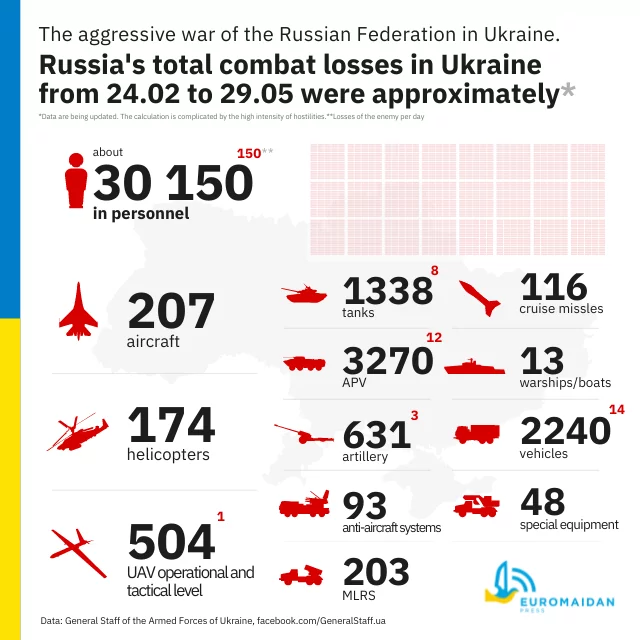
Russian enemy suffered the greatest losses (of the last day) in the Bakhmut direction.
Russians banned from sending supply vehicles to the frontline - Ukrainian Intelligence, the Ukrainska Pravda reports.
“According to Ukrainian intelligence, in order not to lose equipment, commanders of logistics units of occupying troops are prohibiting drivers from evacuating the wounded and bringing food and fuel to forward units. More than 3,000 Russian logistics vehicles continue to be stationed at their permanent deployment points. The Intelligence Directorate notes that since the beginning of the war, Russian logistics troops have already used more than 45% of the vehicles available. However, it has turned out that the entire Russian logistics system cannot meet the needs of a significant number of troops located more than 100 km away from its border.”
Ukraine destroys about 30% of Russia’s modern tanks - Ministry of Internal Affairs, the Ukrinform reports.
“Before the war with Ukraine, Russia had about 3,000 modern tanks in its arsenal and now more than 30% have already been destroyed by our defenders in three months of war. Well, in six months this figure will only increase," [the adviser to the Minister of Internal Affairs of Ukraine, Viktor Andrusiv, said on Channel 24].
Humanitarian
Macron and Scholz demand Putin release Mariupol's defenders, the Ukrinform reports. The Elysee Palace reported this following Macron's phone call with Scholz and Putin, Ukrinform reports.
"The President of the Republic and the German Chancellor have demanded the release of some 2,500 defenders of Azovstal taken prisoner by the Russian forces," the statement said.
According to the statement, Macron, and Scholz in talks with Putin also insisted on the urgency of lifting the blockade of Odesa to allow the export of Ukrainian grain through the Black Sea in order to avoid a world food crisis. "They took note of the Russian President's promise to grant ships access to the port for the export of grain crops without it being exploited militarily by Russia and if it was first cleared of mines," the statement said.
In addition, Macron, and Scholz reiterated to Putin that any solution to the war must be negotiated between Moscow and Kyiv, with respect for the sovereignty and territorial integrity of Ukraine.
https://twitter.com/EuromaidanPress/status/1530604628261347328
G7 countries looking for ways to resume grain exports from Ukraine – Johnson, the Ukrinform reports.
"The Prime Minister outlined to President Zelenskyy the intensive work taking place with international partners to find ways to resume the export of grain from Ukraine to avert a global food crisis. He said that the UK would work with G7 partners to push for urgent progress," the UK government said this in a press release following a phone call between the leaders of the two countries. The British government noted that the leaders "agreed on next steps and the imperative for Russia to relax its blockade and allow safe shipping lanes."
According to UNHCR 6,737,208 refugees have been registered as of May 27. The UN says that so far Poland has taken in 3,581,612 refugees, Romania 989,357, Russian Federation 971,417, Hungary 671,463, Republic of Moldova 477,637, Slovakia 454,961 and Belarus 29,547. Among those who fled Ukraine are also Ukrainian nationals with dual citizenship. An additional 105,000 people moved to the Russian Federation from Donetsk and Luhansk oblasts between 18 and 23 February.
The number of Ukrainians entering Ukraine since February 28 is 2,229,500 as of May 27. This figure reflects cross-border movements, which can be pendular and does not necessarily indicate sustainable returns.
OHCHR recorded 8,766 civilian casualties in Ukraine as of May 26. 4,031 were killed (including 261 children) and 4,735 injured (including 406 children).
Environmental
Nine cultural heritage sites in Ukraine have been destroyed by the occupiers, the Ukrainska Pravda reports.
“Since the beginning of Russia’s full-scale invasion of Ukraine, the occupiers have damaged 367 cultural heritage sites. This was reported by Oleksandr Tkachenko, the Minister of Culture and Information Policy. Currently, we know about the complete destruction of 9 cultural heritage sites in the Donetsk, Kyiv, Sumy, and Chernihiv oblasts. Other sites have suffered varying degrees of damage.”
Legal
War crimes in Ukraine: ICC prosecutor urges Russia to cooperate, the Ukrinform reports. “Karim Khan, a prosecutor with the International Criminal Court, expects cooperation from Russia in a probe into the war crimes committed in Ukraine, [according to Politiko]. Khan stressed that the “invitation is there” and that his “door is open,” so he will “keep knocking” on Russia’s door, too. As Ukrinform reported earlier, almost 14,000 criminal proceedings were initiated into the crimes committed by Russian invasion forces and their allies in Ukraine since the start of the full-scale war.”
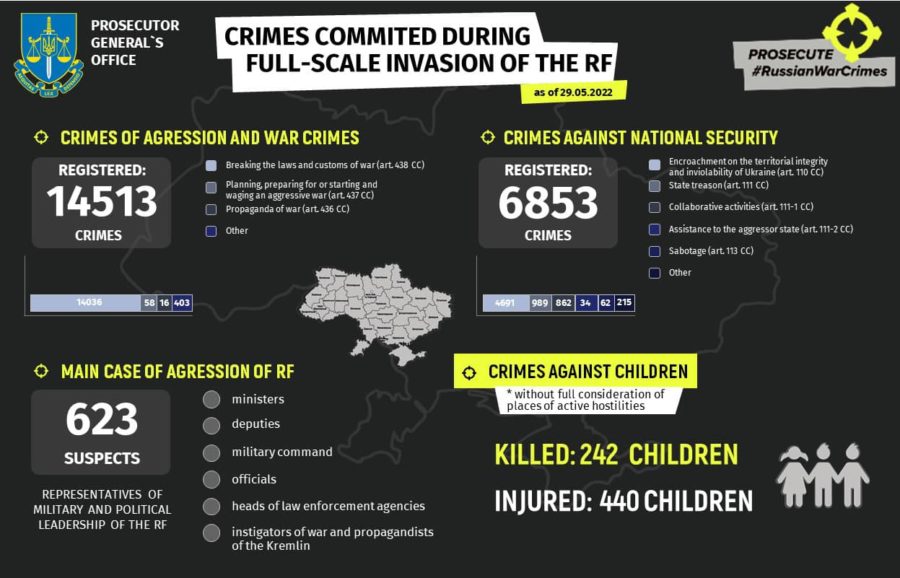 Ship to take metal from Mariupol to Russia; Kyiv decries looting, the Reuters
Ship to take metal from Mariupol to Russia; Kyiv decries looting, the Reuters
reports.
“A ship has entered the Ukrainian port of Mariupol for the first time since Russia completed its capture of the city to load metal and ship it east to Russia, TASS news agency reported on Saturday, in a move that Kyiv decried as looting. A spokesperson for the port told TASS that the vessel would be loading 2,700 tonnes of metal before travelling 160 km (100 miles) east to the Russian city of Rostov-on-Don on Monday. Ukraine's Human Rights Ombudsman Lyudmyla Denisova said the shipment amounted to looting by Russia. Looting in the temporarily occupied territories of Ukraine continues, she wrote on the Telegram messaging app. Following the theft of Ukrainian grain, the occupiers resorted to exporting metal products from Mariupol."
242 children were killed and 440 children injured, the Office of the Prosecutor General of Ukraine reports as of May 29. 1,888 educational establishments are damaged as a result of shelling and bombings, 180 of them are destroyed fully. 14,513 crimes of aggression and war crimes and 6,853 crimes against national security were registered.
Support
New 155-mm-caliber self-propelled artillery and Harpoon missiles arrive in Ukraine, the Ukrainska Pravda reports.
"Three types of 155-mm artillery - the M777 howitzer, FH70 howitzer and Caesar self-propelled howitzer - are already being used successfully on the front line. It was just impossible to imagine this back in March. But today this is a reality, the Ukrainian Minister of Defense, Oleksii Reznikov stated on Facebook. “I’m happy to report the news that the 155-mm artillery fleet is being replenished. M109 howitzers of one of the modifications have already arrived in Ukraine. This is very high-quality equipment.
The coastal defense of our country will not just be reinforced by Harpoon missiles - they will be used by trained Ukrainian teams. I’m sure that the ‘fighting brotherhood’ of Harpoons and our Neptunes [a Ukrainian-made anti-ship cruise missile] will help liberate our Black Sea and make it safe again, as well as reliably protecting our Odesa."
Captured Russian military equipment is equipped with American microchips, the Defense Intelligence of Ukraine (DIU) claims.
“Ukraine's military intelligence has obtained evidence of the use of microelectronics produced in the United States in the armaments and military equipment of the occupying country. Chips of foreign production were discovered by officers of the DIU in the Russian air defense systems "Pantsir", attack helicopters Ka-52 "Alligator" and cruise missiles X-101. Foreign electronic components in the captured enemy technology, once again prove the "effectiveness" of Russia's "import substitution" and emphasize the complete dependence of the aggressor country on Western technology.”
Long-range weapons take on new import in Ukraine, The New York Times reports. “With the battlefield, the focus shifted to Ukraine’s east, both Russia and Ukraine took to showcasing the urgency and superiority of long-range weapons on Saturday.
Russian cruise missiles have caused heavy damage in Ukraine and Ukrainian officials have been appealing for new long-range systems to bring to the fight.
On Saturday, Ukraine’s defense minister, Oleksiy Reznikov, said that sophisticated Harpoon anti-ship cruise missiles had arrived. He said the Harpoons came courtesy of Denmark and would be used to try to break Russia’s Black Sea blockade and to protect the port city of Odesa.
The US-made Harpoons were pledged after a virtual meeting earlier this month of the Ukraine Defense Contact Group, a group of dozens of countries that was formed to support Ukraine with military aid.
News that they had started to reach Ukrainian forces came as American officials said the Biden administration has approved sending long-range multiple launch rocket systems to Ukraine, a significant transfer that could hugely aid Ukraine’s defense of its territory in the Donbas region. Ukraine had been asking for the systems, with Prime Minister Boris Johnson of Britain agreeing on Friday that they should be supplied. […]
Both Ukraine and Russia have deployed heavy artillery along the eastern front, with American-made howitzers reaching Ukrainian forces this month. The new, longer-ranged Western artillery is the most powerful and destructive of the many types now being provided by NATO countries. They fire three miles farther than the most common artillery system used by the Russian army in the Ukraine war, the Msta-S self-propelled howitzer — and 10 miles farther if shooting a precision, GPS-guided projectile.
According to Ukrainian and British officials, Russia has been using one of its most fearsome conventional weapons, a rocket artillery system nicknamed the Heatwave, in a systematic fashion. The system fires thermobaric warheads that send potentially lethal shock waves into bunkers or trenches. Such explosives also called fuel-air bombs or vacuum bombs, scatter a flammable mist or powder that is then ignited and burns in the air.”
New developments
- EU eying option of naval mission to unblock food exports from Ukraine – media, the Ukrinform reports. "The EU is ready to mobilize all possible resources to facilitate the export of grain stored in Ukrainian silos and ports," [according to El Pais.] The issue will be considered on Monday at the summit in Brussels. In particular, it is about efforts to resume exports from the port of Odesa”.
- Putin says Russia is ready to continue negotiations with Ukraine, the Ukrainska Pravda reports, citing The Kremlin. “In a telephone conversation with French President Emmanuel Macron and German Federal Chancellor Olaf Scholz, Russian President Vladimir Putin has said that Russia is ready to continue negotiations with Ukraine.”
- Ukrainian negotiator says any agreement with Russia 'isn't worth a broken penny', the Reuters reports. Ukrainian presidential adviser and peace talks negotiator Mykhailo Podoliak said on Saturday that any agreement with Russia cannot be trusted and Moscow can only be stopped in its invasion by force. "Is it possible to negotiate with a country that always lies cynically and propagandistically?" Russia and Ukraine have blamed each other after peace talks stalled, with the last known face-to-face negotiations on March 29.”
- Moscow-led Ukrainian Orthodox Church breaking ties with Russia, the Reuters reports. “A branch of Ukraine's Orthodox Church that remained loyal to Moscow after a 2019 schism has said it will break with the Russian church over the country's invasion of Ukraine. Following a meeting of its leadership, the church announced that it would declare its "full independence" from Russia. "The council has approved the corresponding additions and changes to the Statute on the Management of the Ukrainian Orthodox Church, indicating the full autonomy and independence of the Ukrainian Orthodox Church," it said in a statement late on Friday.”
- Kuleba wants the world to make Moscow end the blockade of Ukrainian ports, the Ukrinform reports. "Sanctions on Russia have no connection to the unfolding global food crisis. The sole reason for shortages, rising prices and threat of hunger is the Russian military physically blocking 22 million tons of Ukrainian food exports in our seaports. Demand Moscow to end its blockade," the top diplomat said on Twitter.”
Assessment
On the War
The Institute for the Study of War has made the following assessment as of Saturday 28 May:
The Russian invasion of Ukraine that aimed to seize and occupy the entire country has become a desperate and bloody offensive to capture a single city in the east while defending important but limited gains in the south and east. Ukraine has twice forced Putin to define down his military objectives. Ukraine defeated Russia in the Battle of Kyiv, forcing Putin to reduce his subsequent military objectives to seizing Donetsk and Luhansk oblasts in eastern Ukraine. Ukraine stopped him from achieving that aim as well, forcing him to focus on completing the seizure of Luhansk Oblast alone. Putin is now hurling men and munitions at the last remaining major population center in that oblast, Sievierodonetsk as if taking it would win the war for the Kremlin. He is wrong. When the Battle of Sievierodonetsk ends, regardless of which side holds the city, the Russian offensive at the operational and strategic levels will likely have culminated, giving Ukraine the chance to restart its operational-level counteroffensives to push Russian forces back.
 Russian forces are assaulting Severdonetsk even though they have not yet encircled it. They are making territorial gains and may succeed in taking the city and areas further west. The Ukrainian military is facing the most serious challenge it has encountered since the isolation of the Azovstal Plant in Mariupol and may well suffer a significant tactical defeat in the coming days if Sievierodonetsk falls, although such an outcome is by no means certain and the Russian attacks may well stall again.
Russian forces are assaulting Severdonetsk even though they have not yet encircled it. They are making territorial gains and may succeed in taking the city and areas further west. The Ukrainian military is facing the most serious challenge it has encountered since the isolation of the Azovstal Plant in Mariupol and may well suffer a significant tactical defeat in the coming days if Sievierodonetsk falls, although such an outcome is by no means certain and the Russian attacks may well stall again.
The Russians are paying a price for their current tactical success that is out of proportion to any real operational or strategic benefit they can hope to receive. Sievierodonetsk itself is important at this stage in the war primarily because it is the last significant population center in Luhansk Oblast that the Russians do not control. Seizing it will let Moscow declare that it has secured Luhansk Oblast fully but will give Russia no other significant military or economic benefit. This is especially true because Russian forces are destroying the city as they assault it and will control its rubble if they capture it. Taking Sievierodonetsk can open a Russian ground line of communication (GLOC) to support operations to the west, but the Russians have failed to secure much more advantageous GLOCs from Izium partly because they have concentrated so much on Sievierodonetsk.
The Russians continue to make extremely limited progress in their efforts to gain control of the unoccupied areas of Donetsk Oblast, meanwhile. Russian troops have struggled to penetrate the pre-February 24 line of contact for weeks, while Russian offensive operations from Izium to the south remain largely stalled. The seizure of Sievierodonetsk could only assist in the conquest of the rest of Donetsk Oblast if it gave the Russians momentum on which to build successive operations, but the Battle of Severdonetsk will most likely preclude continued large-scale Russian offensive operations.
Russian progress around Severdonetsk results largely from the fact that Moscow has concentrated forces, equipment, and materiel drawn from all other axes on this one objective. Russian troops have been unable to make progress on any other axes for weeks and have largely not even tried to do so. Ukrainian defenders have inflicted fearful casualties on the Russian attackers around Sievierodonetsk even so. Moscow will not be able to recoup large amounts of effective combat power even if it seizes Severdonetsk, because it is expanding that combat power frivolously on taking the city.
Ukrainian forces are also suffering serious losses in the Battle of Sievierodonetsk, as are Ukrainian civilians and infrastructure.
The Russians have concentrated a much higher proportion of their available offensive combat power to take Sievierodonetsk than the Ukrainians, however, shaping the attrition gradient generally in Kyiv’s favor. The Ukrainians continue to receive supplies and materiel from their allies as well, however slow and limited that flow may be. The Russians, in contrast, continue to manifest clear signs that they are burning through their available reserves of manpower and materiel with no reason to expect relief in the coming months.
Evidence of eroding military professionalism in the Russian officer corps is mounting. The Ukrainian Military Intelligence Directorate (GUR) reported that Russian commanders are attempting to preserve military equipment by forbidding drivers from evacuating wounded servicemen or providing supplies to units that have advanced too far. Refusing to risk equipment to evacuate wounded personnel on the battlefield—other than in extraordinary circumstances—is a remarkable violation of core principles of military professionalism. Such behavior can have serious impacts on morale and the willingness of soldiers to fight and risk getting injured beyond their own defensive lines. ISW cannot independently confirm the GUR’s report, but commentary by Russian milbloggers offers some circumstantial support for it. Russian milblogger Alexander Zhychkovskiy criticized the Russian military command’s disregard for reservists on the deprioritized Zaporizhzhia Oblast front. Zhychkovskiy reported that Russian commanders trapped lightly-equipped infantry units in areas of intense Ukrainian artillery fire without significant artillery support and did not rotate other units through those areas to relieve them. Zhychkovskiy noted that Russian commanders are responsible for high losses and cases of insanity among servicemen. Another milblogger, Alexander Khodarkovsky, said that Russian commanders are not sending reinforcements in a timely matter, preventing Russian forces from resting between ground assaults.
Waning professionalism among Russia’s officers could present Ukrainian forces with opportunities. Russian morale, already low, may drop further if such behavior is widespread and continues. If Russian troops stuck on secondary axes lose their will to fight as the Battle for Severdonetsk consumes much of the available Russian offensive combat power, Ukraine may have a chance to launch significant counteroffensives with good prospects for success. That prospect is uncertain and Ukraine may not have the ability to take advantage of an opportunity even if it presents itself, but the current pattern of Russian operations is generating serious vulnerabilities that Kyiv will likely attempt to exploit.
Key Takeaways
- Russian forces pressed the ground assault on Sievierodonetsk and its environs, making limited gains.
- Russian forces in Kharkiv continue to focus efforts on preventing a Ukrainian counteroffensive from reaching the international border between Kharkiv and Belgorod.
- Ukrainian forces began a counteroffensive near the Kherson-Mykolaiv oblast border approximately 70 km to the northeast of Kherson City that may have crossed the Inhulets River.
- Russia’s use of stored T-62 tanks in the southern axis indicates Russia’s continued materiel and force generation problems.
- Ukrainian partisan activity continues to impose costs on Russian occupation forces in Kherson and Zaporizhzhia oblasts.“
No data suggesting Putin may launch an offensive on Kyiv just yet - Ukraine’s Defense Ministry, the Ukrinform reports. "I reached out to the Commander-in-Chief about this issue, as well as with the head of the [DIU] (military intelligence) Kyrylo Budanov. As of today, we have no information that would indicate a possible offensive as soon as today. But we must understand that the threat to Kyiv and the whole territory of Ukraine prevails because we have a war going on, [Deputy Defense Minister Anna] Maliar said.
At the same time, the official noted that aggravating the situation in the media space and creating "panic waves" can most likely be beneficial to the enemy, so they can be releasing such information in test mode.
Yesterday we were looking for the roots where it could first emerge on social networks. And it should be noted that this was, indeed, Russian sources, as well as some of our concerned citizens who made their contribution, said the Deputy Minister.”
Putin’s war grinds on, with dissent from Russian hawks and peace-seekers, The Washington Post reports. “Russian President Vladimir Putin has made it clear that he will not tolerate criticism of his assault on Ukraine. Russians who describe his “special military operation” as an invasion may be imprisoned for up to 15 years, and dissenters have been punished for speaking out. But as the war enters its fourth month, disapproval is increasingly bubbling to the surface — from war hawks who argue the Kremlin has been insufficiently aggressive to officials who don’t want to be part of the bloodshed.
Putin’s early attempt to blitz Ukraine’s major cities failed and the war has morphed into a protracted conflict that may have claimed the lives of as many Russian soldiers as the Soviet Union’s nine-year war in Afghanistan, Britain’s Defense Ministry said this week. Moscow has tried to downplay these losses, but the battlefield setbacks have raised questions.
Signs of resistance are growing. A Russian military court ruled behind closed doors this week that 115 National Guard service members were rightfully terminated for refusing to participate in the invasion. The decision can be appealed, according to the Russian news agency Interfax.
On Friday, a local Communist Party lawmaker in the Far Eastern port city of Vladivostok demanded that the Kremlin cease fighting in Ukraine and withdraw its forces, the Associated Press reported. “We understand that if our country doesn’t stop the military operation, we’ll have more orphans in our country,” Leonid Vasyukevich told a legislative meeting.
And Boris Bondarev, a Geneva-based Russian diplomat, resigned from his posting this week, saying that he is “so ashamed” of his country.
At the same time, Russian nationalists are pushing for greater confrontation with Kyiv and the West. Last week, a group of Russian veterans released a statement laden with the far-right sentiment, in which they appealed to Putin and his military leaders to dispatch more troops to Ukraine and called for more advanced weaponry to be used. They also criticized the Kremlin for withdrawing troops from key battlefields such as Kyiv and Chernihiv in April. Moscow sought to paint the pullback as a good-faith gesture ahead of peace talks with Ukraine, but the veterans characterized it as humiliating.
They were particularly embarrassed by the stunning defeat of Russian troops near the Siverskyi Donets River earlier this month. As many as 485 Russian soldiers died and 80 armored vehicles were lost when Ukrainian artillery blasted a pontoon bridge, according to Ukrainian reports quoted by the Institute for the Study of War and a forensic study by the Atlantic Council. “The special operation is over!” the statement read, using Putin’s preferred term for the war. “A full-blooded war has begun!”
Alexey Muraviev, an expert on the Russian military at Australia’s Curtin University, said the veterans’ statement carried the weight of “battle-hardened specialists” who are likely to be frustrated by the narratives that portray the Russian military as inept. They are accusing the Kremlin of showing a “complete lack of professional competence,” Muraviev said.
Tatiana Stanovaya, the Paris-based head of the R. Politik political consultancy, recently wrote on her Telegram channel that Putin is “stuck between two worlds” in that he can neither crush Ukraine nor retreat with his reputation intact. “Everyone has already forgotten that Putin was once called a president of half-measures,” Stanovaya said. “Of course, everyone is unhappy.”
Hans Petter Midttun’s assessment
I fully support the assessments of ISW concerning the situation on the ground. On the face of it, the cost of taking Sievierodonetsk seems meaningless when considering the human sacrifices, the effect on morale and the reduction of overall operational capabilities.
That said, even if they were to stop the offensive after having taken Sievierodonetsk (which they probably will not), Russia has achieved the following temporary gains:
- Secured a land bridge between Rostov-on-Don and Crimea
- Secured access to water for the Crimean Peninsula, crucial for both the inflated population, tourism, agricultural production and industry.
- Further eroded Ukraine by partly occupying two more oblasts (Zaporizhzhia and Kherson).
- Met one of its stated objectives of “protecting the people of DNR and LNR”
- Turned the Sea of Azov into a Russian lake.
- Established full control over Ukraine’s maritime resources (gas, oil, minerals, fishery)
- Increased its control over the Black Sea, nearly turning it into a Russian lake.
- Demonstrated its willingness to pursue its strategic aim and objectives true the use of military power.
- Established itself (in its own eyes) as a Global Power.
- But most importantly, Russia has effectively stopped 70% of Ukrainian imports and exports and thereby increasing the scope and effect of its economic war against Ukraine to a level that might very well lead to its collapse.
All of which have come at huge costs. Russia has become the most sanctioned country in history. Europe is in the process of making policy shifts that might potentially have a huge impact on its economy for years to come. It is being denied access to Western technology, banking, insurance, ports, airspace, and more. Depending on how the West responds to the forthcoming hint of a ceasefire agreement (“Minsk agreement version 3.0”), Russia might find itself unable to hold on to its gains.
That, however, depends on Western resolve.
The West is not one body and does not act like one. Even though we have seen Europe and the USA come together in a manner we have not seen since the Cold War, we already see signs of division and discord. Europe is struggling to agree on the most painful, but also the most effective sanctions. There is no consensus on what a Ukrainian victory looks like. NATO has not established any “red lines” and is not acting according to its strategic concept, indicating an internal split. The supply of weapons further shows the disparity in strategy on how countries see the war solved. Some are clearly reluctant to provide what Ukraine needs to defeat and evict the Russian forces. Most predictable of all, we have already seen several recommendations for Ukrainian concessions and so-called “peace agreements” at the cost of not only Ukrainian independence and sovereignty but also European stability and security.
It is crucial to acknowledge that the word “destroyed” has a different interpretation when we talk about Ukraine and Russia.
In Ukraine, “destroyed” means more than $1 trillion in damages. The destruction of at least 12 civilian airports, 295 bridges and bridge crossings, 591 kindergartens, 574 healthcare institutions, 108 religious and 179 cultural buildings, 169 warehouses, 19 shopping malls and 38,6 million square meters of residential buildings. It also reflects human suffering, the thousands of killed and maimed, the more than 6,7 million refugees and 8 million internally displaced people. “Destroyed” includes not at least the very real risk of losing the foundation to exist as a nation and a state.
In Russia, “destroyed” refers to the above-mentioned sanctions and restrictive measures, all of which are temporary and might be rectified at the whim of individual countries and their national interests.
Ukraine’s future is not being decided in the East. Its future existence is being effectively undermined in the Black Sea.
Russia is openly confronting NATO. If we fail to act, Russian success in the Black Sea will create global precedence. Having been faced down by a country with the GDP of Spain or Canada, the Alliance might find that its credibility has been “destroyed” as well.


